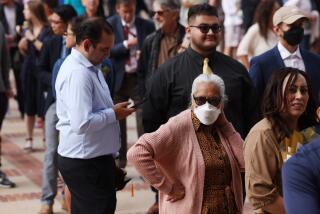L.A. County HIV Testing
- Share via
* We are writing in response to “L.A. County Record Worst in HIV Detection Program” (May 10) and your editorial “Sizing Up the True AIDS Problem” (May 11). In his critique of the Los Angeles County HIV testing and counseling program it is not clear why your reporter did not include 1993 data (available from this office.) Had he done so, he would have found that in 1993 there was a significant expansion of the confidential HIV testing and counseling program in Los Angeles County. The number of testing sites increased from 67 in the first quarter of 1992 to 130 sites by the fourth quarter of 1993. HIV tests at these sites increased 71%, from 25,577 in 1992 to 43,804 in 1993. Testing in Los Angeles actually exceeded all other cities in 1993, including New York City, which performed 43,532 tests.
Furthermore, the number of HIV-infected persons identified in Los Angeles versus the number of persons tested increased from 1.3% to 1.8% (796 HIV-infected persons were identified in 1993 compared to 345 in 1992). Your comparison of “hit rates” in the seven targeted cities ignores important epidemiologic information. The HIV-infection rates in the general population in Los Angeles and in our highest risk groups, i.e., homosexual men and injection drug users, are lower than in the other seven cities. For example, we estimate that approximately 0.5%, or 1 in 200 persons, in the general population of Los Angeles are HIV infected, while homosexual men treated in L.A. County STD clinics have HIV-infection rates of approximately 35%. In comparison, the estimated HIV infection rate in the general population of San Francisco is 4%, or 1 in 25 persons, while homosexual men treated in San Francisco STD clinics have infection rates of 50%. In addition, the infection rate among injection drug users in Los Angeles is under 10% compared to rates between 50% and 60% in New York City. Given this lower background rate of HIV infection in Los Angeles, it is not surprising that we will have to test more people, even in our highest risk groups, to identify the same number of HIV-infected persons.
Finally, your comparison of confidential HIV testing with anonymous testing is inappropriate because it confuses two distinct populations. Anonymous test sites provide service to a group of highly motivated, HIV “informed” persons who have made a conscious decision to seek testing. In contrast, the county’s confidential testing program targets persons who are less knowledgeable about HIV, are unaware that they may be at risk of HIV infection, and are not likely to seek testing.
As the HIV epidemic shifts increasingly into low-income and minority populations, reaching those who are infected will be more labor intensive and, upon superficial analysis will appear to be less “cost-effective.” However, it is imperative that we continue to refine and expand our efforts to reach these populations to allow early identification and referral to treatment as well as to provide education to prevent new infections. Confidential HIV testing targeted to high-risk individuals who are not likely to utilize anonymous testing services is an essential component of this activity.
PAUL SIMON MD, M.P.H.
Medical Epidemiologist
PETER R. KERNDT MD, Director
HIV Epidemiology Program
L.A. County Dept. of Health Services
More to Read
Sign up for Essential California
The most important California stories and recommendations in your inbox every morning.
You may occasionally receive promotional content from the Los Angeles Times.













